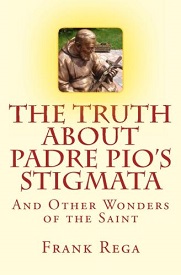Padre Pio on Salvation Outside the (Visible) Church
Frank M. Rega, S.F.O.
Initially published in Christian Order, December 2006 issue.
|
|
Introductory note: This article has been revised and updated from the innitial version, and the word "Visible" has been added to the title. This addition is to clarify that all salvation is from the Roman Catholic Church, which is the Body of Christ. However, the examples in this article show that Padre Pio felt that not being a formal, visible member of the Church during one's lifetime does not preclude a properly disposed person from being incorporated into the Body of Christ, at the time of death.
It is quite common that alleged quotations or viewpoints attributed to Padre Pio have frequently been used to justify the stances, rumors, or agendas of various individuals or groups. Often it is difficult to find reliable documentation to verify his involvement in such scenarios as the “three days of darkness,”1 his alleged opposition to Archbishop Marcel Lefebvre, 2 or his purported support of Garabandal 3 and even Medjugorje 4. Another area of speculation focuses on what he would think of the current state of the Church – where would this Tridentine rite Catholic, known for his lifelong obedience and loyalty to the hierarchy, place his support along the Novus Ordo – Traditionalist – reactionary spectrum? It is not surprising, then, to find some who contend that St. Padre Pio would be an exacting Traditionalist. Thus he would be expected to hold to a strict interpretation of extra ecclesiam nulla salus – outside of the Roman Catholic Church no one can be saved. Among the most notable proponents of this presumed stance of Padre Pio are to be found some Sedevacantists (the See of Peter is vacant, since it has been occupied by invalidly elected and/or heretical popes since Vatican II), as well as the so-called Feeneyites.5 Along with adherence to the true Faith, and being in a state of grace at the moment of death, they would insist that a strict requirement for entering the kingdom of heaven is water baptism, and water baptism alone. “Baptism of Desire” and “Baptism of Blood” are rejected as not being true Catholic dogmas. Neither can those invincibly ignorant of the Faith be saved. Thus, according to them, only Roman Catholics who die faithful to the Church, loyal to the Holy Father, and sealed by validly administered water baptism, can enter heaven. There is a wonderful meditation composed by Padre Pio in which he states: “He [Jesus] sees the sacrileges with which priests and faithful defile themselves, not caring about those sacraments instituted for our salvation as necessary means for it; now, instead, made an occasion of sin and damnation of souls.” 6 From this it can be seen that Padre Pio viewed the sacraments as the “necessary means” of salvation. However, in studying the course of his life and ministry as a Catholic priest, evidence can be found that he understood the sacraments as necessary for all in general, but not for all in particular. Thus, while he believed that the sacraments of the Church are necessary as the normative means of salvation, Padre Pio was willing to admit of exceptions on an individual basis. But these exceptions did not compromise his conviction that the one true Church founded by Jesus Christ is the Roman Catholic Church. Lest anyone be deceived into joining the Sedevacantist camp under the assumption that Padre Pio would support their views if he were alive today, the following documented cases are presented as evidence that Padre Pio believed that non-Catholics could be saved:
Adelaide McAlpin Pyle, a Baptized Protestant King George V of England, a Baptized Protestant Julius Fine, an Unbaptized Devout Jew |
|
Read the complete article in the above book, available in print or Kindle format.
Frank Rega is the author of: Padre
Pio and America,
St.
Francis of Assisi and the Conversion of the Muslims,
The
Greatest Catholic President: Garcia Moreno of Ecuador
Life of the Mystic Luisa Piccarreta
- Journeys in the Divine Will vols. 1 and 2
Life of the Mystic Luisa
Piccarreta - volume 3 in preparation
The
Truth about Padre Pio's Stigmata and Other Wonders of the Saint
Vatican II, Evolution, and Medjugorje: Hubris, Heresy, and Mystery
www.frankrega.com www.sanpadrepio.com www.thepoverello.com www.lifeofluisa.com
This page was last updated on 02/09/14

